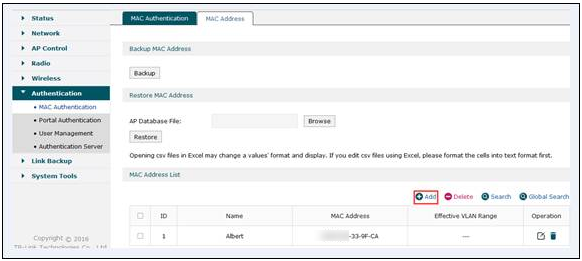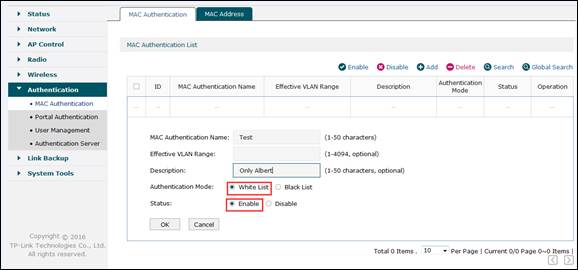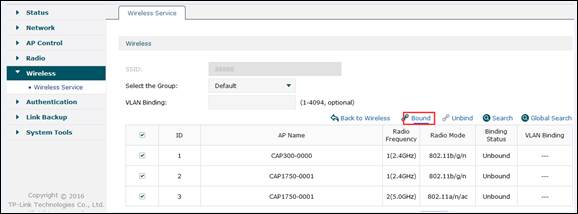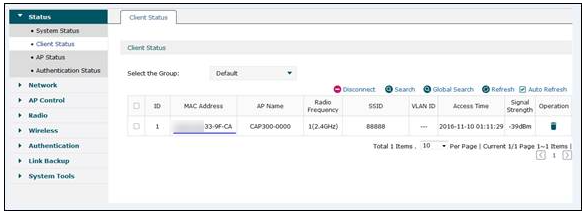How to configure MAC Authentication function on TP-LINK CAP/AC serial products
AC500( V1 ) , AC50( V1 ) , CAP300-Outdoor( V1 ) , CAP1750( V1 ) , CAP1200( V1 ) , CAP300( V1 )
Recent updates may have expanded access to feature(s) discussed in this FAQ. Visit your product's support page, select the correct hardware version for your device, and check either the Datasheet or the firmware section for the latest improvements added to your product. Please note that product availability varies by region, and certain models may not be available in your region.
Why do we use MAC authentication? Since the openness of wireless network, any wireless terminal in the coverage area of the CAPs can get access to the network, which is a great threaten if unexpected devices come up and connect to the wireless network. To improve the security level and allow or deny some certain clients (MAC address ID) can use WIFI, we can set up MAC authentication function by using White List or Black List. This document will introduce how to configure MAC Authentication function on TP-Link CAP/AC Serial product like AC500.
Step 1. Add the MAC address into the MAC Address List (In this instance, we add Albert’s mobile phone’s Mac address in the list).

Step 2. Add the MAC Authentication entry and enable “White List” to make MAC authentication effective.

Note:
- White List: When you choose White List, devices whose MAC addresses are in the MAC Address table are allowed but all the other devices are denied.
- Black List: When you choose Black List, devices whose MAC addresses are in the MAC Address table are denied while all the other devices are allowed.
- Effective VLAN Range: when you fill this option with some certain VLAN IDs, please make sure the corresponding SSIDs are bound to the these VLANs as well; If you leave the option blank, this MAC authentication will take effect to only the SSIDs that are not bound with any VLANs.
Step 3. Create wireless SSID and bound it to CAP.


Step 4. Now we use Albert’s mobile phone to connect to Wi-Fi “88888” and we can see the wireless connection can be established successfully. But if we use other clients whose MAC address is not in the white list, wireless connection will be refused.

Finden Sie diese FAQ hilfreich?
Mit Ihrer Rückmeldung tragen Sie dazu bei, dass wir unsere Webpräsenz verbessern.
Was ist Ihr Bedenken bei diesem Artikel?
- Mit Produkt unzufrieden
- Zu kompliziert
- Irreführende Titel
- Betrifft mich nicht
- Zu ungenau
- Was anderes
Vielen Dank.
Vielen Dank für Ihr Feedback.
Von United States?
Erhalten Sie Produkte, Events und Leistungen speziell für Ihre Region
Diese Webseite verwendet Cookies, um die Websitenavigation zu verbessern, Online-Aktivitäten zu analysieren und die bestmögliche Nutzererfahrung auf unseren Webseiten zu haben. Sie können der Verwendung von Cookies jederzeit Widersprechen. Nähere Informationen finden Sie in unseren Datenschutzhinweisen.
Your Privacy Choices
Diese Webseite verwendet Cookies, um die Websitenavigation zu verbessern, Online-Aktivitäten zu analysieren und die bestmögliche Nutzererfahrung auf unseren Webseiten zu haben. Sie können der Verwendung von Cookies jederzeit Widersprechen. Nähere Informationen finden Sie in unseren Datenschutzhinweisen.
Notwendige Cookies
Diese Cookies sind zur Funktion der Website erforderlich und können in Ihren Systemen nicht deaktiviert werden.
TP-Link
SESSION, JSESSIONID, accepted_local_switcher, tp_privacy_banner, tp_privacy_base, tp_privacy_marketing, tp_top-banner, tp_popup-bottom, tp_popup-center, tp_popup-right-middle, tp_popup-right-bottom, tp_productCategoryType
Youtube
id, VISITOR_INFO1_LIVE, LOGIN_INFO, SIDCC, SAPISID, APISID, SSID, SID, YSC, __Secure-1PSID, __Secure-1PAPISID, __Secure-1PSIDCC, __Secure-3PSID, __Secure-3PAPISID, __Secure-3PSIDCC, 1P_JAR, AEC, NID, OTZ
Zendesk
OptanonConsent, __cf_bm, __cfruid, _cfuvid, _help_center_session, _pendo___sg__.<container-id>, _pendo_meta.<container-id>, _pendo_visitorId.<container-id>, _zendesk_authenticated, _zendesk_cookie, _zendesk_session, _zendesk_shared_session, ajs_anonymous_id, cf_clearance
Analyse- und Marketing-Cookies
Analyse-Cookies ermöglichen es uns, Ihre Aktivitäten auf unserer Website zu analysieren, um die Funktionsweise unserer Website zu verbessern und anzupassen.
Die Marketing-Cookies können über unsere Website von unseren Werbepartnern gesetzt werden, um ein Profil Ihrer Interessen zu erstellen und Ihnen relevante Anzeigen auf anderen Websites zu zeigen.
Google Analytics & Google Tag Manager
_gid, _ga_<container-id>, _ga, _gat_gtag_<container-id>
Google Ads & DoubleClick
test_cookie, _gcl_au







